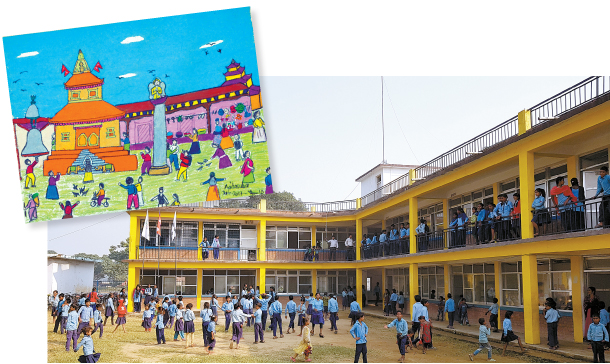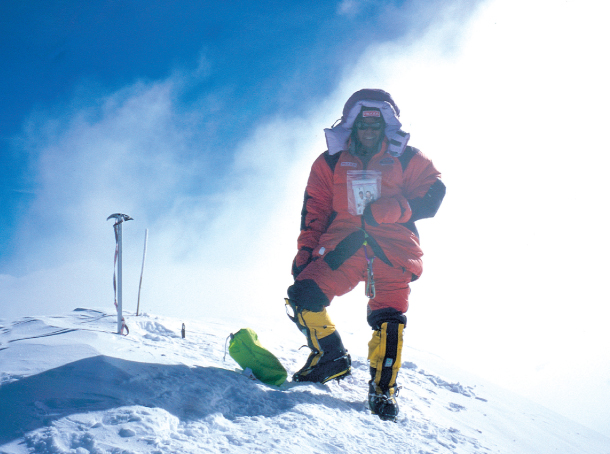Climber ventures to help kids reach new heights: After reaching the world’s highest peaks, Um Hong-gil is dedicated to giving back

Now-retired climber Um Hong-gil talks at the office of his Um Hong Gil Human Foundation in Jung District, central Seoul. [PARK SANG-MOON]
“I am the mountain and the mountain is me,” said Um, “One needs to know how to adapt oneself to nature so that they become one with the mountain.”
“I gained a lot of knowledge at school, but what inspired me to understand myself was the mountains,” he added during an interview with the Korea JoongAng Daily.
Although it’s been over a decade since he officially retired from his life as a professional climber, the Himalayas remain an important part of his life thanks to the promise he made to the mountain range.
As he climbed the mountains, he focused on what he could and would do to give back to the people of the region who helped him fight through his challenges on each climb. By the time he reached his 16th Himalayan mountaintop in 2007, he knew exactly what he wanted to do.
“As I got more desperate to make my dream come true, the scenes of the people who had supported me came to mind, and I repeatedly said to myself that there are so many things I want to give back to the mountains and the people. I couldn’t only focus on what I wanted to achieve,” said Um. What he could do best was provide the people with schools where they could get a proper education.
“It’s not that I wrote a contract with anyone that I should build a school, and I never officially announced that I had the idea of building schools during my climb, but the closer I got to the top, the more I thought about the people who were down on the ground.”
In 2008, he created the Um Hong Gil Human Foundation to build 16 schools in the Himalayas for the children of mountain guides who usually don’t have access to a quality education. If their fathers get into any kind of accident while hiking, the children often have to forgo education as it becomes something their families can no longer afford. In the 10 years since the foundation began, it has raised enough money to build 16 schools, two temples and a hospital. The 16th school will be constructed next year and a 17th school is set to welcome students in the coming years.
“We have built a reputation that the Um Hong Gil Human Foundation builds schools even in remote areas and those who want to provide something for those living in remote areas come looking for us,” said Um. The expert climber says he won’t stop looking for new places to build schools so that young children can get the chance to develop their dreams and make them come true, just like he did while climbing the slopes.

A painting, top left, made by a student at Birethanti Secondary School, the fourth school the Um Hong Gil Human Foundation built, located in Kaski, Nepal. Above is Sundi Secondary School, the 10th school the foundation built, located in Rupandehi, Nepal. The foundation initially planned to build 16 schools to commemorate the 16 Himalayan peaks Um has climbed, but the foundation plans to open more in the coming years. [UM HONG GIL HUMAN FOUNDATION]
A. The schools follow the Nepalese educational system, so we do not have to set up a separate curriculum. What we do is provide the hardware because the schools there are outdated or just don’t exist in some areas. If a computer lab is needed, we jump in. If a library or a gym is needed, we listen and take care of the request. That was what we have done for the past 10 years.
Although the schools follow the local education system, over the next 10 years we will focus on adding more extracurricular activities, such as art or physical education classes. Since one thing we want to do is continuously take care of these schools and update things that are outdated, adding a few programs that aren’t part of the regular educational system in Nepal is something we can do as well. At the moment, the foundation has hired 13 teachers to teach the regular classes at schools. We also give out scholarships to those who want to continue their studies, but don’t have the resources. I want to support the children and help them become the kinds of people capable of contributing to changing their country. And I hope those who have gotten support from the foundation become the ones who help others in the future.
Have you done anything to help students in Korea?
I take middle school students to the mountains on the second Saturday of every month. Some are troublemakers and some are hardworking students who want to enjoy some outdoor activities. Through hiking, students learn how to be patient and how to be more humane. I watch them change over time: at first they all act as if they can live life without giving or receiving help, but we find these students asking others for help, whether they need a hand with their heavy backpacks or sharing the food they have. They learn what it’s like to be part of a community out in nature. The foundation also has a program where students undergo training at a military base. Some of the kids who do well during the program get to go to Nepal every year. Once they see how differently children their age live in Nepal, they seem to change their outlook on life.

Um Hong-gil at the top of Kangchenjunga in the Himalayas, Nepal, in 2000, the 12th peak he reached in the mountain range. [UM HONG GIL HUMAN FOUNDATION]
I go to mountains in Seoul like Mount Bukhan or Mount Dobong every weekend. And I climb mountains outside of Seoul about twice a month. Compared to the mountains in the Himalayas, the size of Korean mountains is different. While the weather at the peaks in the Himalayas is usually winter-like, Korean mountains have four distinct seasons. Although mountains in Korea are smaller and lower, they have their own charms and beauty. Every mountain always looks new and pretty to me.
Are you afraid of climbing any mountain?
You know how dangerous climbing a mountain can be. The more you know, the more scared you get. When I look at a mountain, I see the inside of it, such as what kinds of rocks there are and what kinds of trees will greet me.
What was it like to climb the 16th peak you stepped on in 2007?
As you get mentally and physically tired, you feel desperate, as well as feel the urge that you need to get through this. All of a sudden, my mind was occupied with what I could give back to the Himalayas if I made the trip work. I was thinking I wouldn’t enjoy the glory of getting to the 16 different peaks just by myself. I made a promise to the Himalayas. As the Himalayas kept their promise of getting me to the top, it was then my turn to keep my promises.
What do you eat while you go up?
We prepare lots to eat. There are things you really crave on the ground, but those things are not necessarily what you want to eat when you are in the mountains. Usually we bring gochugaru - hot pepper powder - and containers of salted fish to make kimchi. Meat and vegetables can be found on-site, so we bring condiments. We make naengmyeon - cold noodle soup - as well as rice over jjajang sauce - black bean sauce - or curry, and we make chicken soup as well. Since the Himalayas are inland, the area has a lot of meat, but lacks seafood. We bring seasoned mackerel, and all kinds of dried fish or fermented fish such as hongeo. These are prepared on a special day when the leader of the team decides to feed the members a special meal. These are what we eat at base camp, which is at an altitude of around 5,000 meters (16,404 feet).
Don’t you also eat a lot of instant food?
That is a fundamental part of our diet when we are up in the mountains. When we go up, most of the things we pack are instant food which can be quickly prepared. Dried tofu and dried rice, which only need some water to become edible, are some of the greatest things we can eat.
How do you pick who gets to climb all the way up to the peak and who gets to be part of the support team?
Normally it takes about a month from a base camp to the peak. The climbing team makes the routes to go up and the support team follows to bring the rest of the things the climbers need. When we set up the last campsite before getting to the top, we decide a day to make the climb’s final steps. By the time we get there, the leader of the team usually figures out who is the most fit. You naturally learn who has more endurance and who can make it up to the top. Not everybody has the same physical condition, energy and skills. The members also know whether they can be a leading member after spending about a month on the snowy mountain.
Do you miss spending time in the Himalayas?
I do miss the times when I was so passionate and took on challenges with all my energy. I miss the times I was covered in snow and tried to make my way up. The image is still so vivid in my heart and I miss it everyday. I may fall behind when it comes to agility now, but as you know, going up a mountain isn’t something you plan to do in a short amount of time. It is a long term activity that you need to endure for a month or two. I think I still have that endurance.
You were away from your family a lot while you were working your way up the mountains. Any advice to other young climbers who struggle with not being able to be with their family?
Go all the way. If you are not up for that, don’t even start. If you are trying to kill two birds with one stone, you won’t get both. When you go up beyond the base camp to the top, you need to forget everything that’s happening on the ground. You will face situations where you either survive or die, and distractions and thoughts about anything other than the mountains can lead to your death.
You have witnessed the deaths of beloved members of your climbing team. Has that changed your view of death?
Death is something humans are scared of. But what’s even scarier than death is the fight with yourself. Death is nothing. Being dead and being alive aren’t so different because whether you live or die isn’t really up to you: there is no gap between life and death. Death is always in your life, so I don’t think about whether I will die. That actually gave me more freedom and inspired me to have more confidence in what I do. I don’t know what will happen either today or tomorrow, and that is why I need to do the best I can do. I think I just overcame that fear.
BY LEE SUN-MIN [summerlee@joongang.co.kr]










with the Korea JoongAng Daily
To write comments, please log in to one of the accounts.
Standards Board Policy (0/250자)